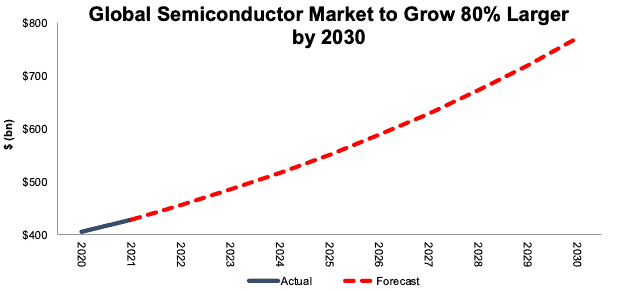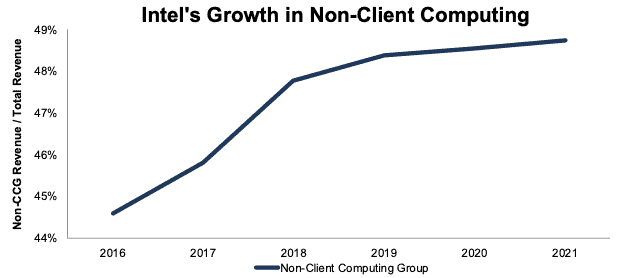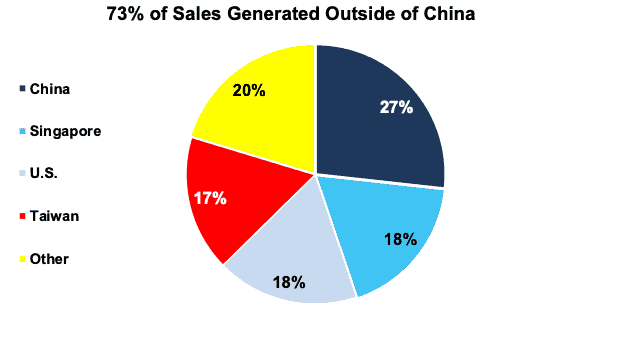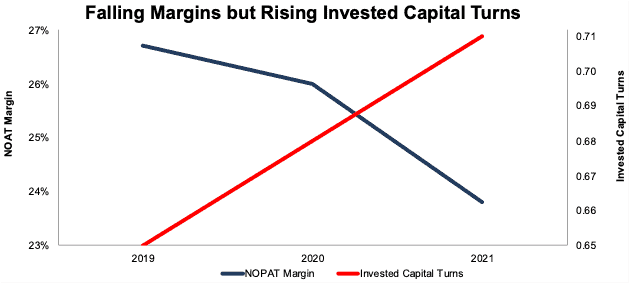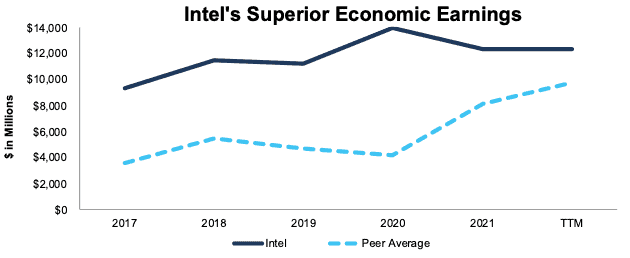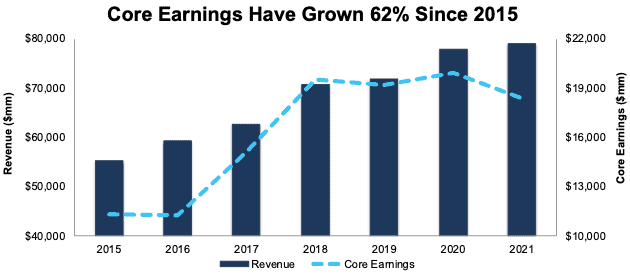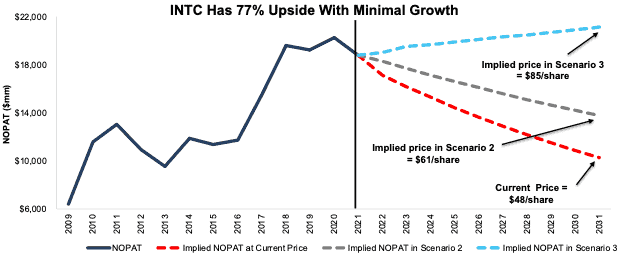We closed this Long Idea on September 29, 2023. A copy of the associated Position Close report is here.
Despite struggles to launch new products, rising geopolitical pressure, and increased competition, this company is making the necessary investments to address the challenges it faces. The stock price indicates the market is expecting a worst-case outcome, but this company is Too Big To Fail for the U.S. economy. Intel (INTC: $48/share) is this week’s Long Idea.
We originally made Intel a Long Idea in August 2020. Since then, the stock is up 2% versus a 37% gain for the S&P 500. Our most recent update is here. Despite its underperformance, INTC still presents quality risk/reward given the company’s:
- position to grow with the increasing semiconductor demand
- ability to leverage its scale to successfully transform its business
- $50+ billion of investments in its new foundry business
- stock has 27%+ upside even if 100% of all business in China disappears
Industry Tailwinds Will Push Revenue Higher
Strong industry tailwinds create long-term demand for Intel’s products even as it struggles to execute the launch of new products. Per Figure 1, Precedence Research projects the global semiconductor market will grow 7% compounded annually from 2021 to 2030.
Figure 1: Global Semiconductor Market Value: 2020 – 2030
Sources: New Constructs, LLC and Precedence Research
In addition to the overall semiconductor industry, Intel supplies the following markets, each of which are poised for strong growth in the coming years:
- personal computers: 9% CAGR through 2025 according to Research And Markets
- data center: 11% CAGR from 2021 – 2030 according to Allied Market Research
- semiconductor packaging: 9% CAGR from 2021 – 2030 according to Allied Market Research
- AI edge computing: 21% CAGR through 2030 according to Allied Market Research
- cloud services: 16% CAGR from 2020 – 2027 according to Research And Markets
- 5G IOT: 70% CAGR from 2021 – 2030 according to Allied Market Research
- autonomous vehicles:25% CAGR from 2020 – 2030 according to Research And Markets
Revenue Growth Despite Market Share Losses
While still supplying 75% of the CPU market, Intel is losing market share to Advance Micro Devices (AMD), which has taken advantage of Intel’s poor product launch execution. Even with the loss in market share in its client computing and data center segments, Intel’s diversified product portfolio helped the firm achieve its best-ever revenue in 2021.
Client computing (i.e. personal computers) has long been Intel’s largest segment, but the firm has successfully shifted its business to higher-growth segments such as internet of things, which grew 35% year-over-year (YoY) in 2021.
Though client computing’s revenue has grown in six consecutive years, Intel’s non-client computing segments have grown even faster. Non-client computing revenue as a percent of total revenue rose from 45% in 2016 to 49% in 2021, per Figure 2.
Figure 2: Intel’s Non-Client Computing Group Sales as Percent of Total: 2016 – 2021
Sources: New Constructs, LLC and company filings
Strategic Shift to Regain Technological Leadership
Intel acknowledges it is technologically behind its competitors, and its new CEO launched an ambitious plan just six weeks after taking the helm that marks a strategic shift for how the firm approaches its business. Intel is moving toward a “developer-first approach based on openness, choice, and trust.” That is marketing-speak for offering high-end foundry services that will compete with the Taiwan Semiconductor Manufacturing Company.
Intel has traditionally shunned the foundry approach, partly as a means of protecting intellectual property. By being more open with its technology, the firm stands to gain from its partnerships without creating new competitors. Case-in-point is Intel’s collaboration with International Business Machines (IBM), which is aimed at beating TSMC to market with 3 nanometer technology. In the partnership, IBM is leading the logic design work, and Intel is handling the manufacturing. This collaborative approach ties IBM in as a large customer for decades rather than pushing IBM to consider entering semiconductor manufacturing. IBM gains from the partnership because Intel’s logic design will be optimized for IBM’s machine languages.
A Clear Path Forward
Intel’s strategic plan drives long-term revenue and volume growth through a focus on three areas:
Product Leadership: The firm is committed to initiatives that bring the firm’s technology back to a technological leadership position while increasing its overall volume output. After falling behind with the delay of its Intel 4 product, the firm plans to deliver five new process nodes in four years to regain its leadership position. The firm is already delivering Intel 7, which is comparable to AMD’s most advanced datacenter chip, and is on track, or ahead of the schedule, outlined in July 2021 for Intel 4, 3, 20A, and 18A.
External Foundries: In addition to making chips for others, Intel is designing its chips with the flexibility to be built by third parties. By designing more of its products to take advantage of external foundries, the firm will become more flexible and insulated from production disruptions. Flexible, modular designs also allow rapid incorporation of new innovations.
Intel Foundry Services: The creation of a foundry business creates an additional revenue stream that leverages the firm’s industry relationships, intellectual property (IP), manufacturing expertise, and deep pockets. Foundry customers will have the ability to build highly customized products that incorporate their own IP with Intel’s internal manufacturing IP.
Leveraging Scale to Execute Growth Initiatives
Intel is the largest company (by revenue) in the semiconductor industry and is more integrated than its competitors. Intel designs and manufactures chips and is now entering the foundry business.
Not only does the firm generate the most revenue in the industry, but it also spends the most on research and development (R&D). Investment in R&D will play a key role in the firm’s drive to regain its technological leadership position. Per Figure 3, Intel’s R&D is 2x Qualcomm’s, 3x Nvidia’s and 5x Advanced Micro Devices’.
Establishing foundries allows the firm to further monetize its decades-long manufacturing expertise and design IP beyond its own chips. Developing a foundry business is expensive and fraught with proposed projects that never happen, but Intel is showing it’s serious about building foundries. In 2021, the firm announced plans to invest $20 billion to develop two new foundries in Arizona and another $20 billion to build two new leading-edge foundries in Ohio. Additionally, the firm will invest $10.5 billion to equip existing sites with advanced packaging capabilities. Intel laid the groundwork for these new investments by lobbying – and receiving – local, state, and federal incentives.
Given the level of investment Intel plans, investors should take solace in the fact that the firm generates the cash to support its foundry-related initiatives. Over the past five years, Intel generated $50.4 billion (26% of market cap) in free cash flow (FCF). Intel’s cumulative FCF since 2016 is 1.4X more than Taiwan Semiconductor Manufacturing Company’s (TSM), 2.2x Qualcomm’s, and 25x Advanced Micro Devices’.
Figure 3: Research & Development Spending: Intel Vs. Peers: TTM
Sources: New Constructs, LLC and company filings
Intel Lowers Industry’s Exposure to Taiwan’s Geopolitical Risk
Intel is ramping up a foundry business as rising threats from China toward Taiwan increase demand for foundry capacity outside of Asia.
The current semiconductor shortage highlights the heavy reliance the world has on Taiwan, which accounts for 63% of the global market. Taiwan Semiconductor Manufacturing Company accounts for 54% of the global semiconductor market alone and is by far the largest foundry for “fabless” semiconductor firms that contract manufacturing to a third party. Any disruption within this region has large ramifications to the global supply chain.
Intel’s established manufacturing presence in the United States and Europe will benefit from increased demand for chips away from Taiwan.
Diversified Customers and Manufacturing Mitigates Risk From China
Intel is heavily exposed to China and will no doubt suffer losses in that market if geopolitical relations become hostile. However, Intel’s regional diversification means that 73% of its sales are outside of China, per Figure 4. By favoring Chinese firms, the government of China has unintentionally created a situation where Intel has more to gain by the world locking out its Chinese competitors than it stands to lose from being locked out of China.
More importantly, Intel’s manufacturing is more regionally diversified than the industry that is extremely reliant on Taiwan-based manufacturing. Should the geopolitical situation continue to deteriorate in Taiwan, Intel could see unprecedented demand for its products and foundry services.
Figure 4: Intel’s Revenue by Region: 2021
Sources: New Constructs, LLC and company filings
Rise in Domestic Interests Further Reduces China Risk
Over the last few decades, the rise in manufacturing in Taiwan has come at the expense of manufacturing in the U.S. The U.S. share of global semiconductor manufacturing fell from 37% in 1990 to just 12% in 2020. Pre-COVID discussions about U.S. vulnerability to the semiconductor supply chain went into high gear once COVID hit. Policymakers are taking bipartisan steps to fund a localized semiconductor industry, as evidenced by the CHIPS and COMPETES Acts. With a greater political eye towards the threats related to dependence upon China, Intel will likely receive support from its home country, especially if its relationship with China sours.
U.S. trade restrictions are already adding additional barriers for Chinese-based competition. For example, U.S. trade restrictions prevent Chinese-government backed Semiconductor Manufacturing International Corporation (SMIC) from importing the extreme ultraviolet (EUV) equipment it needs to manufacture more advanced chips.
In August 2021, the U.S. Department of Defense (DoD) awarded Intel a contract to provide semiconductors for products critical for DoD systems. As the DoD looks to bring more security around its critical systems, U.S. manufacturers, such as Intel are likely to get even more business.
Innovation Is China’s “Achilles Heel”
Successful semiconductor manufacturing requires access to large amounts of money and experienced manufacturing. The Chinese government can offer one of these resources – and it is – but it cannot replicate the experience needed to run a successful, innovative semiconductor operation.
China has been clear about its intent to develop its semiconductor industry. In 2020 alone, China registered 22,000 new semiconductor companies. However, it is misguided to think that China’s plans to grow its production of semiconductors means the country will effectively compete in the global semiconductor manufacturing industry as it has in other industries such as apparel and steel.
China has proven to be capable of replicating manufacturing processes, however, it has admittedly long struggled to innovate. President Xi Jinping in a speech from January 2016 stated that the weakness of China’s economy is “mainly reflected in the lack of strength in innovation ability, which is the ‘Achilles heel’ of this lug of an economy of ours.”
Constant innovation in the semiconductor industry insulates Intel from the disruption Chinese firms have wrought in other industries by simply copying existing technologies. China’s inability to lead technologically means it will always demand more sophisticated products produced by companies from outside of the country, such as Intel. Simply put, the Chinese will not be able to keep up with industry advancements at the pace it needs to become a major threat to Intel.
Don’t Overlook Improved Invested Capital Turns
Given its decline over the past three years, concern over Intel’s falling net operating profit after tax (NOPAT) margins is warranted. However, margins aren’t the only driver of profitability, and Intel is more profitable than its falling margins suggest. While margins provide insight to a company’s operating efficiency, invested capital turns reveal its capital efficiency.
As Intel’s margins fell from 27% in 2009 to 24% in 2021, invested capital turns improved from 0.65 to 0.71 over the same time. As a result, the firm’s return on invested capital (ROIC), the best measure of the firm’s profitability, only fell slightly from 17.4% to 16.8% over the same time.
Going forward, with the development of a lower-margin foundry business, improving invested capital turns will be of utmost importance for the firm. If Intel can add volume to its existing operating efficiency the firm will be positioned for rapid and profitable growth.
Figure 5: Intel’s NOPAT Margins Vs. Invested Capital Turns: 2019 – 2021
Sources: New Constructs, LLC and company filings
Economic Earnings Powerhouse
Intel generates more economic earnings than its peers. Economic earnings reveal actual shareholder value creation and account for the complete set of available financial information. Per Figure 6, Intel’s economic earnings rose from $9.4 billion in 2017 to $12.3 billion in 2021 or 7% compounded annually. Despite the average economic earnings of the peer group increasing from $3.6 billion to $8.1 billion or 23% compounded annually from 2017 to 2021, Intel’s current economic earnings of $12.3 billion are much higher than the TTM weighted-average peer group economic earnings of $9.8 billion.
Peers include Advanced Micro Devices, Inc. (AMD), NVIDIA Corporation (NVDA), Taiwan Semiconductor Manufacturing Company Limited (TSM), Broadcom Ltd (AVGO), QUALCOMM Inc. (QCOM), Texas Instruments, Inc. (TXN), and Micron Technology, Inc. (MU) and 55 other firms in the semiconductor industry.
Figure 6: Intel’s Economic Earnings Vs. Peers: 2017 – TTM
Sources: New Constructs, LLC and company filings
Core Earnings Are Still Historically High Even After Dip in 2021
After peaking in 2020, Intel’s Core Earnings fell to $18.4 billion in 2021. However, per Figure 7, even after falling in 2021, Intel’s Core Earnings are 62% above 2015 levels. With plans to construct four new foundries in the U.S. underway, the firm is positioned to grow Core Earnings from 2021 levels over the long term.
Figure 7: Intel’s Revenue & Core Earnings Since 2015
Sources: New Constructs, LLC and company filings
INTC Has 77% Upside With Minimal Growth
Intel’s price-to-economic book value (PEBV) of 0.6 means the stock is priced for profits to fall, permanently, by over 40% from 2021 levels. Below we use our reverse discounted cash flow (DCF) model to analyze three future cash flow scenarios highlight the upside in Intel’s current stock price.
DCF Scenario 1: to Justify the Current Stock Price of $48/share.
If we assume Intel’s:
- NOPAT margin falls to 23% (10-year average vs. 24% in 2021) in 2022 through 2031 and
- revenue falls at a -6% CAGR (vs. 2022 – 2023 consensus estimate CAGR of +2%) from 2022 – 2031, then
the stock is worth $48/share today – equal to the current stock price. In this scenario, Intel earns $10.3 billion in NOPAT in 2031, or 45% below 2021.
DCF Scenario 2: Shares Have 27% Upside Even If China-Based Sales Fall to $0.
Though extremely unlikely, even if China develops its own semiconductor industry and kicks Intel out of the country in the next 10 years, Intel’s stock still has large upside. In this scenario, we assume Intel:
- maintains 2021 NOPAT margin of 24% (vs. 26% in 2020) from 2022 through 2031, and
- revenue falls 27% from 2021 – 2030 ( loses all sales to China-based companies)
In this scenario, the stock is worth $61/share today – a 27% upside to the current price. In this scenario, Intel’s NOPAT falls to just $13.7 billion in 2022, or 27% below 2021.
DCF Scenario 3: Shares Are Worth $85+.
If we assume Intel:
- maintains 2021 NOPAT margin of 24% from 2022 through 2031,
- revenue grows at a 2% CAGR from 2022 - 2023, and
- revenue grows at a 1% CAGR from 2024-2031 then
the stock is worth $85/share today – a 77% upside to the current price. In this scenario, Intel’s NOPAT grows just 1% compounded annually for the next decade. For reference, Intel grew NOPAT 4% compounded annually over the past 10 years and 10% compounded annually since 2016. In this scenario, Intel’s NOPAT in 2031 is $21.1 billion, or just 4% above 2020 levels. Should Intel’s NOPAT grow in line with historical growth rates, then the stock has even more upside.
Figure 8 compares Intel’s historical NOPAT to its implied NOPAT in each of the above DCF scenarios.
Figure 8: Intel’s Historical and Implied NOPAT: DCF Valuation Scenarios
Sources: New Constructs, LLC and company filings
Sustainable Competitive Advantages Will Drive Shareholder Value Creation
Here’s a summary of why we think the moat around Intel’s business will enable it to continue to generate higher NOPAT than the current market valuation implies.
- massive financial, technological, and experience requirements create huge barriers to entry
- strong demand for large scale U.S.- and European-based semiconductor manufacturing capabilities
- diversified product line reduces execution risk
- ability to generate large free cash flow funds investments to position firm for future growth
- high profitability compared to peers
- as the “national champion” of the U.S. semiconductor industry, government help is available
What Noise Traders Miss With Intel
These days, fewer investors focus on finding quality capital allocators with shareholder friendly corporate governance. Instead, due to the proliferation of noise traders, the focus is on short-term technical trading trends while more reliable fundamental research is overlooked. Here’s a quick summary of what noise traders are missing:
- long-term demand for semiconductors
- improving invested capital turns largely offset decline in NOPAT margin
- China’s innovation shortcomings
- valuation implies 27% upside even if sales in China go to zero
Earnings Beats or More Collaboration Could Send Shares Higher
Despite the negative news around Intel’s ability to execute its product launches, according to Zacks, Intel has beaten earnings estimates in each of the past 12 quarters. Doing so again could send shares higher.
Should Intel attract new foundry customers such as Qualcomm and Amazon, through its redesigning efforts, the market may realize that Intel is well on the way to executing its foundry strategy. More growth for this new segment would be good news for Intel’s shares.
Additionally, if the firm continues to expand its relationship with the DoD, the firm’s top and bottom lines could see a boost that would send shares higher.
Dividends and Share Repurchases Could Provide 6.7% Yield
Intel has increased its quarterly dividend in every year since 2014. Since 2017, Intel has paid $27.4 billion (14% of current market cap) in cumulative dividends. The firm’s current dividend, when annualized, provides a 3.0% yield.
Intel also returns capital to shareholders through share repurchases. From 2017 to 2021, the firm repurchased $44.6 billion (23% of current market cap) of stock. The firm has $7.2 billion remaining on its repurchase authorization. If the company uses its remaining repurchase authorization in 2022, the buybacks will provide an annual yield of 3.7% at its current market cap.
Executive Compensation Plans Could Be Improved
No matter the macro environment, investors should look for companies with executive compensation plans that directly align executives’ interests with shareholders’ interests. Quality corporate governance holds executives accountable to shareholders by incentivizing them to allocate capital prudently.
Intel compensates executives with salaries, cash bonuses, and long-term equity awards.
Intel’s annual cash bonuses are tied to GAAP net income and revenue targets. The firm’s restricted stock units (RSUs) are tied to stock price appreciation targets and performance stock units (PSUs) are tied total shareholder return versus a benchmark and cumulative EPS growth.
Tying executive compensation to GAAP earnings is better than non-GAAP metrics, but GAAP earnings can be misleading. For example, we made $1.1 billion (5% of GAAP earnings) in adjustments to convert Intel’s GAAP earnings to NOPAT. Furthermore, the firm does not hold management accountable for the total amount of capital invested in the company.
Instead of GAAP or total shareholder return, we recommend tying executive compensation to ROIC, which evaluates the companies true returns on the total amount of capital invested in the company, ensures that executives’ interests are aligned with shareholders’ interests as there is a strong correlation between improving ROIC and increasing shareholder value.
Nonetheless, Intel’s focus on profitability, has helped it grow economic earnings from $6.9 billion in 2016 to $12.3 billion in 2021.
Insider Trading and Short Interest Trends
Over the past 12 months, insiders have bought 258 thousand shares and sold 240 thousand shares for a net effect of ~18 thousand shares purchased. These purchases represent less than 1% of shares outstanding.
There are currently 61.8 million shares sold short, which equates to 2% of shares outstanding and just under two days to cover. Short interest decreased 10% from the prior month. The lack of short interest reveals not many are willing to bet on more downside in this stock.
Critical Details Found in Financial Filings by Our Robo-Analyst Technology
Fact: we provide more reliable fundamental data and earnings models – unrivaled in the world.
Proof: Core Earnings: New Data & Evidence, forthcoming in The Journal of Financial Economics.
Below are specifics on the adjustments we make based on Robo-Analyst findings in Intel’s 10-K and 10-Qs:
Income Statement: we made $8.2 billion of adjustments, with a net effect of removing $1.1 billion in non-operating income (1% of revenue). You can see all the adjustments made to Intel’s income statement here.
Balance Sheet: we made $66.9 billion of adjustments to calculate invested capital with a net decrease of $25.3 billion. One of the largest adjustments was $9.5 billion in asset write-downs. This adjustment represented 7% of reported net assets. You can see all the adjustments made to Intel’s balance sheet here.
Valuation: we made $86.6 billion of adjustments to shareholder value for a net effect of decreasing shareholder value by $4.8 billion. Apart from total debt, one of the most notable adjustments to shareholder value was $34.0 billion in excess cash. This adjustment represents 17% of Intel’s market cap. See all adjustments to Intel’s valuation here.
Attractive Fund That Holds INTC
The following funds receive our Attractive-or-better rating and allocate significantly to INTC:
- Invesco Buyback Achievers ETF (PKW) – 4.5% allocation and Attractive rating
- Invesco Dow Jones Industrial Average Dividend ETF (DJD) – 3.6% allocation and Attractive rating
- Acquirers Fund (ZIG) – 3.4% allocation and Very Attractive rating
- TSW Large Cap Value Fund (TSWEX) – 3.1% allocation and Attractive rating
- LeaderShares AlphaFactor Tactical Focused ETF (LSAT) – 3.1% allocation and Attractive rating
- RiverFront Dynamic U.S. Dividend Advantage ETF (RFDA) – 3.0% allocation and Attractive rating
This article originally published on February 9, 2022.
Disclosure: David Trainer, Kyle Guske II, and Matt Shuler receive no compensation to write about any specific stock, style, or theme.
Follow us on Twitter, Facebook, LinkedIn, and StockTwits for real-time alerts on all our research.

